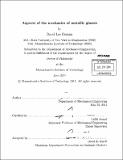| dc.contributor.advisor | Lallit Anand. | en_US |
| dc.contributor.author | Henann, David Lee | en_US |
| dc.contributor.other | Massachusetts Institute of Technology. Dept. of Mechanical Engineering. | en_US |
| dc.date.accessioned | 2011-12-09T21:28:02Z | |
| dc.date.available | 2011-12-09T21:28:02Z | |
| dc.date.copyright | 2011 | en_US |
| dc.date.issued | 2011 | en_US |
| dc.identifier.uri | http://hdl.handle.net/1721.1/67585 | |
| dc.description | Thesis (Ph. D.)--Massachusetts Institute of Technology, Dept. of Mechanical Engineering, 2011. | en_US |
| dc.description | Cataloged from PDF version of thesis. | en_US |
| dc.description | Includes bibliographical references (p. 131-139). | en_US |
| dc.description.abstract | Metallic glasses are amorphous materials that possess unique mechanical properties, such as high tensile strengths and good fracture toughnesses. Also, since they are amorphous, metallic glasses exhibit a glass transition, and at temperatures above this glass transition, they soften dramatically and are therefore amenable to net-shape thermoplastic forming processes. This combination of superior properties and the ability to precisely form complex geometries makes metallic glasses attractive materials for structural applications. This thesis addresses several issues related to the mechanics of these materials: " Metallic glasses are near-"ideal" isotropic materials. We have conducted numerical experiments - using molecular dynamics simulations - to develop a continuum-level isotropic elastic free energy that accounts for volumetric-deviatoric coupling effects under circumstances involving large volumetric strains. " We have developed a large-deformation, elastic-plastic constitutive theory for metallic glasses that incorporates a cavitation mechanism to describe the onset of "brittle" failure. Using this theory, we have conducted finite element simulations of fracture initiation at notch tips in a representative metallic glass under Mode-I, plane strain, small-scale-yielding conditions. We show that our theory predicts important experimentally-observed, fracture-related phenomena in metallic glasses. " We have developed a large-deformation, elastic-viscoplastic constitutive theory in a temperature range, which spans the glass transition of these materials. The numerical simulation capability based on the theory is used to determine appropriate processing parameters in order to carry out a successful micron-scale hot-embossing operation for the thermoplastic forming of a Zr-based metallic glass tool for the manufacture of polymeric microfluidic devices. * The numerical simulation capability is also used to study surface tension-driven shape recovery of a Pt-based metallic glass and quantitatively determine the surface tension of this material above the glass transition. | en_US |
| dc.description.statementofresponsibility | by David Lee Henann. | en_US |
| dc.format.extent | 168 p. | en_US |
| dc.language.iso | eng | en_US |
| dc.publisher | Massachusetts Institute of Technology | en_US |
| dc.rights | M.I.T. theses are protected by
copyright. They may be viewed from this source for any purpose, but
reproduction or distribution in any format is prohibited without written
permission. See provided URL for inquiries about permission. | en_US |
| dc.rights.uri | http://dspace.mit.edu/handle/1721.1/7582 | en_US |
| dc.subject | Mechanical Engineering. | en_US |
| dc.title | Aspects of the mechanics of metallic glasses | en_US |
| dc.type | Thesis | en_US |
| dc.description.degree | Ph.D. | en_US |
| dc.contributor.department | Massachusetts Institute of Technology. Department of Mechanical Engineering | |
| dc.identifier.oclc | 763390125 | en_US |
